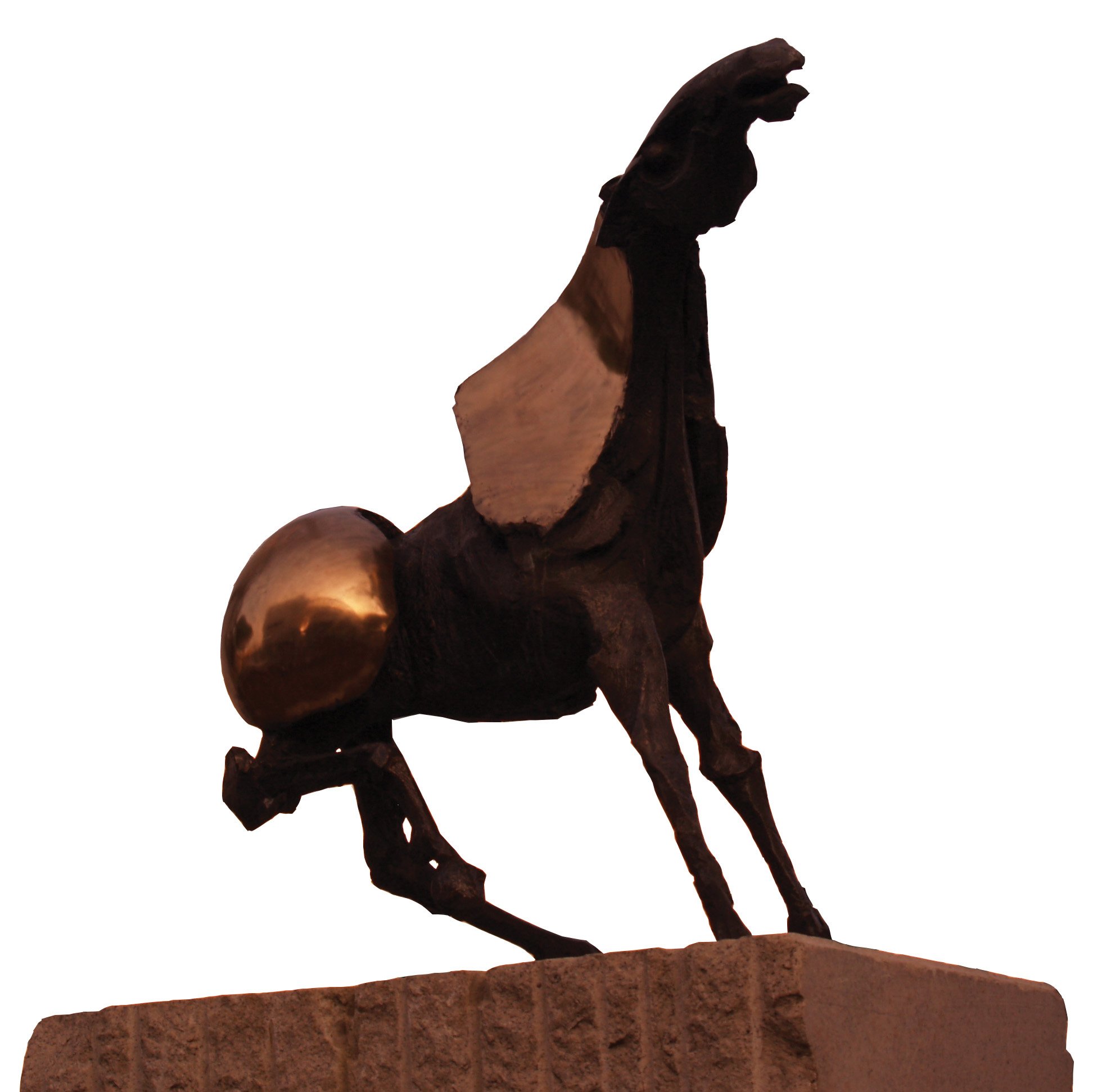It was not only the British who were talking about Brexit at the Marmomacc stone exhibition in Verona at the end of September. Whatever it might eventually mean, it has certainly stimulated interest in the UK stone market.
As we headed towards passport control in Verona there were two channels to follow. One for European passports, the other for non-European passports. An English voice piped up: “Are we allowed to go in the European queue?”
Of course we are. We are not out of Europe yet. But if it is confusing for the British, it is no less confusing for other Europeans. Quite what the European referendum decision in the UK would mean was a matter being discussed a lot at Marmomacc in Verona at the end of September.
Darren Bill, a Director of the UK company Roccia Machinery, which sells GMM saws and edge polishers in the UK among other machinery, said in the previous issue of this magazine that Marmomacc would be an interesting barometer of the level of confidence in the UK decision to leave Europe.
After the show it looks as if the barometer is reading ‘fine’, at least for the stone industry. Just as when countries in Europe had their own currencies everyone wanted Deutsche Marks and flocked to Stone+tec in Nuremberg, they now seem to want Sterling.
That bodes well for the Natural Stone Show in London next year (25-27 April, once again at ExCeL), where overseas companies as well as those from the UK will be hoping to increase their share of the British market, which seems to have gone into overdrive since it recovered from the shock of the Brexit result.
As we keep being told, the UK has the fifth largest economy in the World and the World seems keen to earn a share of it.
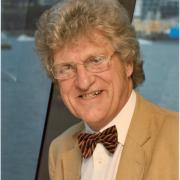 EuroRoc, the confederation of European stone associations, has even elected a representative from Stone Federation Great Britain as its President. He is Peter Harrison (pictured right), of consultants Harrison Goldman, who took over the Presidency during Marmomacc.
EuroRoc, the confederation of European stone associations, has even elected a representative from Stone Federation Great Britain as its President. He is Peter Harrison (pictured right), of consultants Harrison Goldman, who took over the Presidency during Marmomacc.
The British Stone Federation had a presence at the show for the first time – on the EuroRoc stand. And Federation member Nick Williams from Burlington Stone, as well as Peter Harrison, spoke at the seminars held in conjunction with the exhibition.
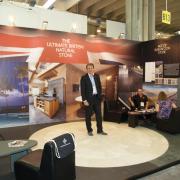 Burlington Stone was, once again, one of just three British stone producers exhibiting in a small British stone enclave at Marmomacc. The other companies were Albion Stone and Forest of Dean Stone Firms, both of which have also exhibited in Verona several times before.
Burlington Stone was, once again, one of just three British stone producers exhibiting in a small British stone enclave at Marmomacc. The other companies were Albion Stone and Forest of Dean Stone Firms, both of which have also exhibited in Verona several times before.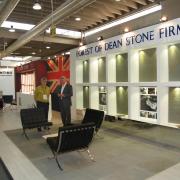
For the British, the weakness of the pound can only have been a bonus, effectively reducing the price of their stones, although no British stone is exactly cheap.
This was Burlington’s sixth year at Marmomacc and it now exports half the stone it produces from its eight quarries in Cumbria. Nick Williams, who is Burlington’s Commercial Director, describes Marmomacc as a “good crossroads” to meet the company’s customers from all over the World, as well as winning new business.
It was because Marmomacc attracts customers from all over the World that Phil Harding was among Burlington’s representatives on the stand. Burlington asked Phil to go to the USA for two years to sell its stone to the Americans. That was 27 years ago and he is still there. A focus of Burlington’s stand this year was its Baycliff limestone paving.
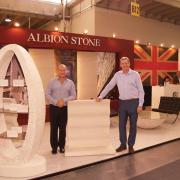 Albion Stone and Forest of Dean Stone Firms started exhibiting in 2013 and can only dream of half their sales coming from exports. They have persisted with their stands at Marmomacc, hoping to build relationships with regular visitors to the exhibition. But, as Nick Horton, the Managing Director of Forest of Dean Stone Firms, said in Verona: “I’m still looking for that elusive export market.”
Albion Stone and Forest of Dean Stone Firms started exhibiting in 2013 and can only dream of half their sales coming from exports. They have persisted with their stands at Marmomacc, hoping to build relationships with regular visitors to the exhibition. But, as Nick Horton, the Managing Director of Forest of Dean Stone Firms, said in Verona: “I’m still looking for that elusive export market.”
Peter Worrall, Albion’s Contracts Director, said some of the company’s Portland stone was going abroad, notably at the moment to Australia for a memorial commemorating those who lost their lives in the World War I battle of Flanders. The company was hoping for a big, prestigious development overseas like those it is famous for supplying in London – projects such as Chelsea Barracks, which is one of the biggest developments underway in Europe.
But it was a good show for the Italians, who have struggled to break free of the grip of the economic downturn. There were 1,650 companies exhibiting from 53 countries, including a notable increase in the presence of Turkey, both of its stone companies and its machinery makers.
The main countries represented on the stands other than Italy itself were Germany, the United States and Spain. There was also a big increase in Chinese exhibitors, indicating the world economy is getting back on its feet.
Overseas visitors came from 146 countries, including debuts for Nigeria and Mozambique, to contribute to a total attendance of about 67,000, according to the organisers, which is the highest number for a long time.
 There was a feeling this was a new dawn for the Italian stone industry, which was reflected in the announcement that the exhibition is in future to be given a new identity and rebranded as Marmo+Mac.
There was a feeling this was a new dawn for the Italian stone industry, which was reflected in the announcement that the exhibition is in future to be given a new identity and rebranded as Marmo+Mac.
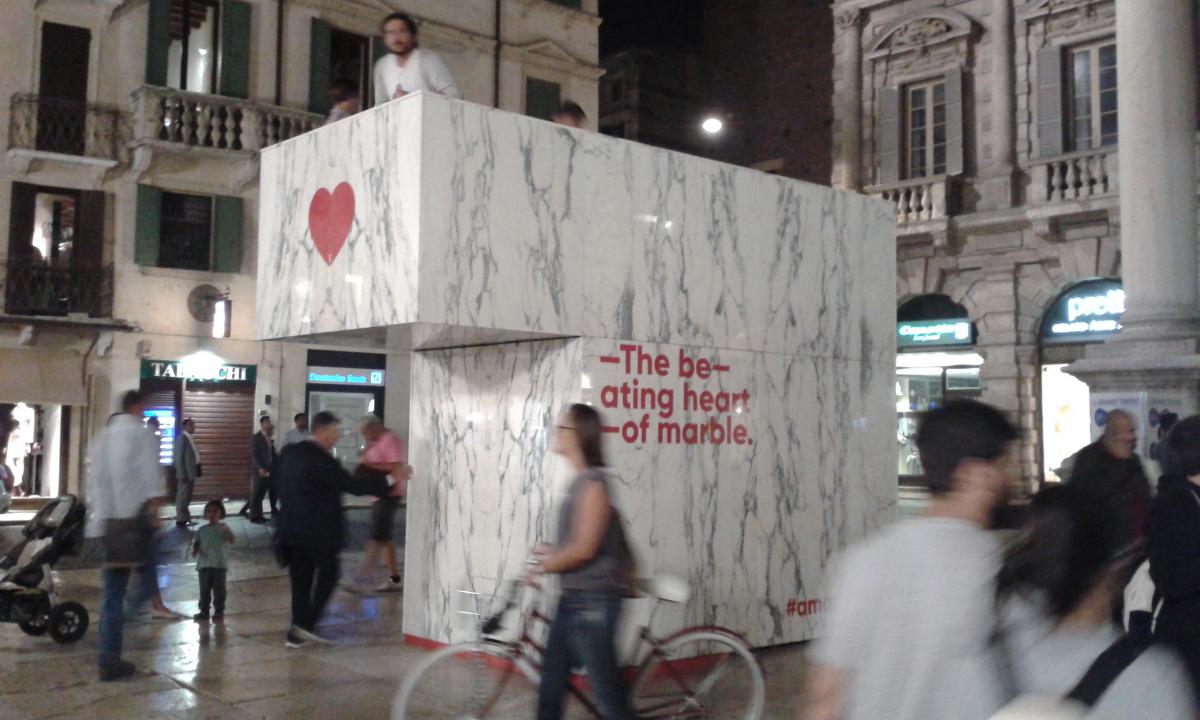 The fair even reached out into the historic centre of Verona, where public art in stone was sited in the piazzas for the show and left there throughout October.
The fair even reached out into the historic centre of Verona, where public art in stone was sited in the piazzas for the show and left there throughout October.
Giovanni Mantovani, CEO and Director General of Veronafiere, said the show “is today the B2B and promotion platform for the sector thanks to more internationalisation than ever.”
During the four days of the fair the Italian Stone Theatre highlighted the interaction of stone, design and technology. The artistic stonework on show was conceived by man and made by machine. There are pictures of some of the pieces and other pictures from the exhibition here.
Machinery was, of course, one of the reasons many of the visitors from the stone industry itself, rather than its customers and specifiers, had attended the exhibition. They wanted to see the latest developments. As usual, many of the UK machinery agents were on the stands of their principals to welcome visitors from England and Ireland.
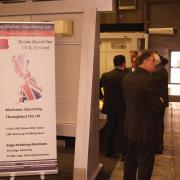 Pat Sharkey Engineering had posters up on the Sasso stand announcing itself as the agent for the company in the UK and Ireland, while LPE Group once again had its own stand. It continues to build its European distribution network for the American Laser Products digital templaters and this time was also showing the materials handling products of another American company, Omni Cubed, which it is also now distributing exclusively throughout Europe.
Pat Sharkey Engineering had posters up on the Sasso stand announcing itself as the agent for the company in the UK and Ireland, while LPE Group once again had its own stand. It continues to build its European distribution network for the American Laser Products digital templaters and this time was also showing the materials handling products of another American company, Omni Cubed, which it is also now distributing exclusively throughout Europe.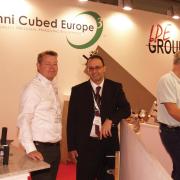
LPE Group Directors Carl Sharkey and Simon Bradbury were splitting their time between their LPE Group stand and the stands of other companies whose products they sell in the UK, such as Breton CNC machinery and Comandulli edge polishers and saws.
There were plenty of other familiar faces in Verona and even more familiar products. Some of those from the UK were visiting for the first time. Others had returned after quite a gap. NSS ran into father and son Mike and Rob Critchley of memorial masonry equipment supplier The Blast Shop on Friedrich Goldmann’s stand. The Blast Shop sells Goldmann’s gritblasting equipment in the UK. Mike and Rob had visited Marmomacc previously, but not since 1983. They felt it was time they took another look.
There were developments on the machinery side to be seen, most noticeably the increasing number of heads being put on to bridge saws and the growing number of waterjet cutters, both as stand alone machines and mounted in combination with saw blades. T&D Robotics, represented in the UK by Roccia Machinery, has mounted a waterjet on to a robot arm. You can find out more about the developments in machinery by referring back to last month’s issue of Natural Stone Specialist magazine.
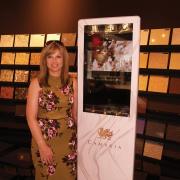 Many of the international wholesalers operating in the UK were exhibiting at the exhibition with their UK management in attendance, while UK wholesalers were also there, both looking for new opportunities and supporting their suppliers. Bernard Hogan, for example, from Granite Granite, was on the Cambria stand (Granite Granite sells Cambria in the UK) with Theresa Fox, a consultant from Invoke Marketing, which makes the digital display screens supplied by Granite Granite in the UK to showrooms that sell Cambria surfaces. And on the Lapitec stand was Stephen Pike, from UK wholesaler The Marble & Granite Centre, which has exclusivity on the UK distribution of the superdense sintered surfaces from Lapitec in the UK.
Many of the international wholesalers operating in the UK were exhibiting at the exhibition with their UK management in attendance, while UK wholesalers were also there, both looking for new opportunities and supporting their suppliers. Bernard Hogan, for example, from Granite Granite, was on the Cambria stand (Granite Granite sells Cambria in the UK) with Theresa Fox, a consultant from Invoke Marketing, which makes the digital display screens supplied by Granite Granite in the UK to showrooms that sell Cambria surfaces. And on the Lapitec stand was Stephen Pike, from UK wholesaler The Marble & Granite Centre, which has exclusivity on the UK distribution of the superdense sintered surfaces from Lapitec in the UK.

